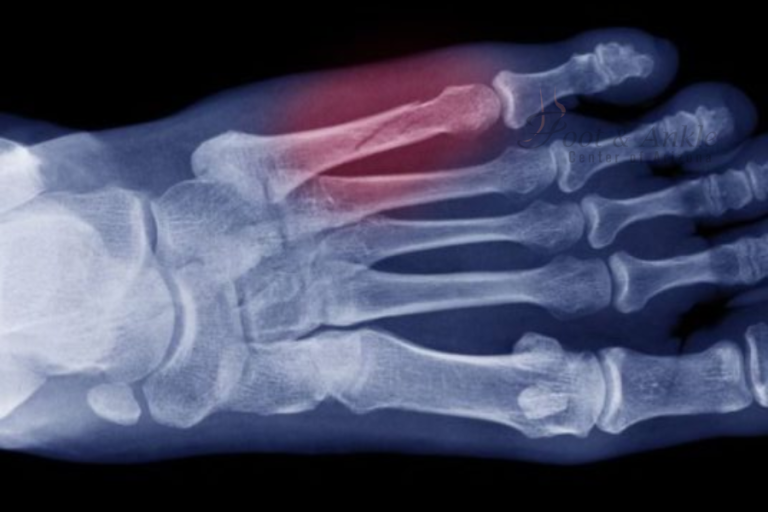Our feet take much abuse during the day. With cramped shoes and similar motions repeated over and over, it can be hard on our toes. They include an infected toe if it goes without treatment; it may be painful and further complicate things.
At Foot and Ankle Center of Arizona, ensuring the health of your feet is paramount. The following article discusses toe infections, specifically how to soak an infected toe at home for treatment. Other treatment options are also covered, along with when you need professional help.
How to Know if You Have a Toe Infection
There are characteristic or common symptoms that can reap off the degree of infection in the toe. These are as follows:
- Pain and tenderness: This is usually the predominant symptom and is then focused on the site of infection.
- Redness and swelling: Such an infected toe would then turn red, and swollen, more so when there is pus collection.
- Warmth: An infected toe would feel warm to the touch.
- Pulsating sensation: You may experience a throbbing or pounding sensation in the toe that is affected.
- Pus underneath nail: In some individuals, pus may build up underneath toenail displacement, discoloration, and largely elevation of the toenail.
What Causes Toe Infections?
A toe infection can occur for many various reasons. These are some of the most common:
Ingrown toenail: This occurs when a corner of the toenail digs into the surrounding skin, thereby irritating the skin and opening up a path by which bacteria may enter.
Fungal infection (athlete’s foot): The athlete’s foot is a fungal infection that prefers a warm, humid environment. It may even infect the toenails from the parts of the adjoining skin.
Injury: A stubbed toe and other kinds of injury may cause the skin to break or split, allowing bacteria to enter the deeper tissues.
People who have diabetes are more prone to develop diabetic foot ulcers. The reason is unsatisfactory circulation and nerve damage.
How to Soak an Infected Toe
Soaking an infected toe can represent a short, simple procedure for the reduction of inflammation and swelling, which eases pain and encourages healing. Here is a step-by-step guide on how to soak an infected toe:
Gather your supplies You will need a basin or footbath, warm water—not hot—Epsom salts if wanted, mild soap, and a clean towel.
Soak preparation:
Fill the basin with warm water, enough so the toe will be fully submerged. Add 1-2 tablespoons of Epsom salts for extra pain and swelling relief. Note: A good supply of Epsom salts are usually located at any drugstore. If you do not get Epsom salts, that is quite all right; plain warm water will work.
Clean your toe:
Wash the infected toe with mild soap and warm water before soaking. This is to clean off all surface bacteria and other dirt.
Soak your toe:
Soak the infected toe for 15-20 minutes. Do this 3-4 times a day, especially during the period when your infection is at its worst.
Dry thoroughly:
After soaking, dry your foot completely, especially between the toes. This should be done with a clean, soft towel.
More To Come—Home Remedies for an Infected Toe
While soaking is pretty helpful, here are some additional suggestions which help the healing process along and keep the infection from becoming worse:
Elevation: Elevate your foot above heart level as much as possible. This can help reduce swelling.
Over-the-counter pain relievers: You may take over-the-counter pain relievers like ibuprofen or acetaminophen for your discomfort.
Wear proper shoes: Wear those shoes that fit loosely and have a good amount of ventilation. This keeps your feet breathing and won’t irritate anything further around the foot.
Apply a bandage: Apply a light bandage to protect the infected toe from further irritation. Change daily if there is drainage or open wounds to keep it clean.
When to Seek Professional Help
Mild infections of the toe can be treated by soaking and cautious home care. However, it is very important to seek medical care if the infection won’t go away or gets worse. The following are signs that it’s time to visit a doctor:
Severe pain or swelling: If the pain or swelling is too great and is getting worse instead of better with home care, then it is time to come in to see the doctor.
Fever: If there is a fever, then this could indicate a worse infection present that needs antibiotic care.
Red streaks down the leg: This could be indicative of an infection that is spreading. The process needs to be addressed promptly.
Diabetic foot ulcers: If you have diabetes, complications can ensue from infections of the feet. If you have diabetes and develop a toe infection, see your doctor right away.
Pus drainage that doesn’t improve: If the infected toe discharges pus and it does not appear to get better with soaking and home care, or if the drainage is excessive, then you should seek a podiatrist or doctor.
Treatment Options by the Podiatrist
If your infected toe needs professional help, different treatment options can be oriented toward your problem by a podiatrist, or a foot and ankle specialist. Depending on the severity and cause of infection, he or she may consider the following options:
Antibiotics:
Your podiatrist may prescribe oral antibiotics if the infection is bacterial to fight the bacteria and clear the infection.
Antifungal drugs:
If the infection is fungal, like an athlete’s foot spreading to toes, then topical creams of antifungal medications or oral drugs may be required.
Debridement:
The podiatrist may have to remove, in certain severe cases, dead tissue or pus from the infected area so that healing can begin.
Nail removal:
If there is a severe infection below the toenail, in some cases, partial or complete removal of the nail may have to be performed so proper medication can be applied and it does not let the infection ‘hide’ under the nail plate.
Prevention is Key
Even though toe infections respond to good treatment, prevention is always the best medicine. Get started on keeping your toes healthy and infection-free with these tips:
Practice good foot hygiene:
Wash your feet daily with warm water and some soap, scrubbing well between the toes. Dry your feet well after washing, particularly the spaces between the toes, so that moisture will not collect and initiate an infection.
Wear good shoes:
Ensure the fit of shoes is good and that they are well-ventilated. These will give minimum irritation and won’t crowd the toes.
Cut toenails correctly:
Toenails are supposed to be cut straight across since this helps prevent ingrown nails. There is no need to cut them too short or to round the corners.
Examine your feet:
Take a good look at your feet daily. Look for redness, swelling, or injuries. This enables you to detect any problem from developing into an infection when not dealt with appropriately.
Control underlining conditions:
Proper management of diseases such as diabetes or any other illnesses that may involve blood flow or nerve functions to your feet is the key to preventing a complication of the foot, infection.
Foot and Ankle Center of Arizona: Your Partner in Foot Health
At Foot and Ankle Center of Arizona, we believe in delivering comprehensive foot and ankle care to all age groups. Be it an infection in the toe or some other condition of the foot, do not hesitate to consult our expert podiatrists for the same. Our practice features a comfortable atmosphere, along with the usage of advanced diagnostic tools for accurate diagnosis and treatment, customized to your needs, so that you may resume regular activities with the least discomfort.
Conclusion
Toe infections can be quite painful but are generally easily treated if appropriate care is taken. Soaking a swollen toe can be done at home by applying some remedies that help reduce the swelling and eventually cure the infection. However, it is necessary to know when the infection in the toe has worsened and then visit a doctor for immediate treatment. You can considerably reduce your chances of getting a toe infection by following the above-mentioned tips and keeping proper hygiene of the feet.




